BLACK SPOTS IN DIAMONDS
LET'S LOOK AT BLACK SPOTS, DOTS AND SPECKS IN DIAMONDS
This post contains affiliate links. If you use these links to buy something I may earn a commission. Thanks! As an Amazon Associate I also earn from qualifying purchases.
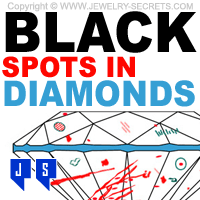
What are Black Spots in a Diamond?
Black Spots, or more commonly referred to as, Black Carbon Spots, are Crystal Inclusions that formed in a Diamond when the Diamond was born.
Black Spots (also called Pepper) are one of the most common Inclusions found in a Diamond. The basic reason for this is simple: They’re the easiest to spot.
Black Spots in a white Diamond stand out and a lot of times become very apparent. I see people wipe their Diamond with their finger thinking it’s dust or dirt on the stone, but it’s not. It’s trapped inside the Diamond and has been there for over a million years. That Black Spot is going nowhere! It’s in there for life.
Black Spots can look like small dark flakes, or they can congregate together and look like a massive eye sore.
Other noticeable flaws in a Diamond include: Cloudy Areas, Cracks, Lines, Pinpoints, Chips…
Take a look at the image below and the official Diamond Plot terminology…
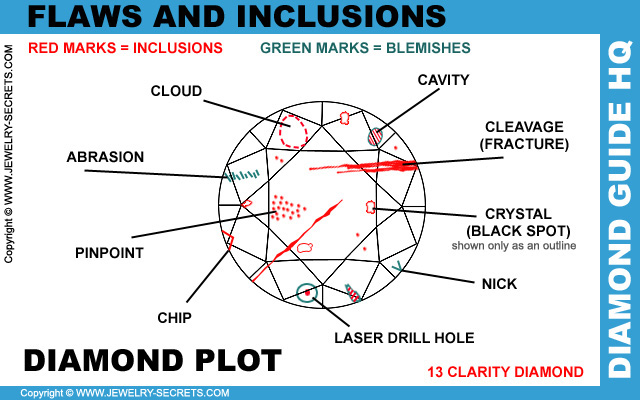
Some people don’t notice Black Spots at first (shown only as an outline on a Plot). But once they do spot them, they’ll never stop looking at them. It’s one of those distracting things that take away from the beauty of a Diamond.
The main reason why people didn’t know the Inclusion was there, was because they didn’t learn about the Clarity of the Diamond they were buying and they didn’t take the time to Microscope their stone.
Diamond Clarity and Black Spots
If you can see Black Spots in a Diamond with your naked eye (unaided), it usually means only one thing: That Diamond is an I Clarity Diamond.
I Clarity means Included! There are three ranges of I Clarity Diamonds (I1, I2 and I3) and each drop in level earns you more Inclusions and BIGGER visible Inclusions. See image of I Clarity Diamonds below…
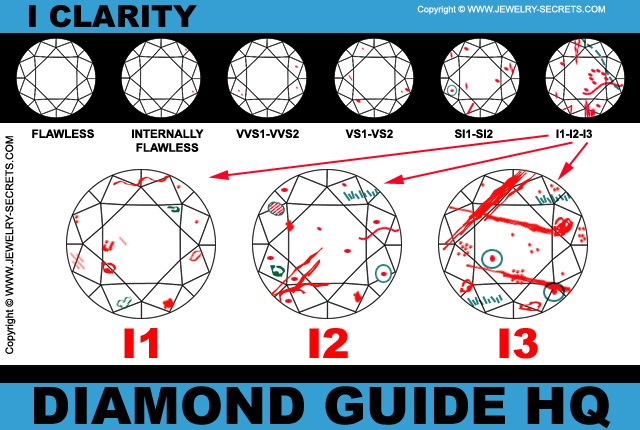
I Clarity means there are eye-visible flaws in the stone and if you think they stand out now, you should see them under a jeweler’s loupe (10x Magnification). That’s an eye-opener!!!
Sometimes the flaws in an I Clarity Diamond are so plentiful, the Diamond will look cloudy or hazy with little or NO Brilliance at all. Inclusions stop light in its track and make the Diamond sparkle less.
So if you can see the flaws just by peeking at the Diamond, consider it an I Clarity stone.
Clarity is Rare
People wonder why Jewelry Stores would sell Diamonds with such huge visible flaws in them. It all comes down to rarity.
Even Diamonds of this Clarity are still very rare in nature (nature is NOT perfect!).
Anything I3 or higher are Gem Quality Diamonds and make up only the top 15% of all the Diamonds mined in the world today.
So even a Diamond filled with Black Spots, Lines, Cracks and Fractures is still a rare find. That’s why they hold their price and why stores sell them.
To get away from visible flaws, you’ll have to spend more money and move up in Clarity.
To compare the price differences for Diamonds with the only thing changing being Clarity, compare the Price Chart below… (All Diamonds are 1 Carat, G Color, Ideal Cut and GIA Certified). (Prices taken from James Allen at the time of this post.)
| CARAT WEIGHT, CLARITY, COLOR, CUT, CERTIFIED | PRICE | VIEW |
| 1.00, I1, G, EXCELLENT, GIA | $3,400 | VIEW |
| 1.00, SI1, G, EXCELLENT, GIA | $5,610 | VIEW |
| 1.00, VS1, G, EXCELLENT, GIA | $7,580 | VIEW |
As you can see, each and every step in Clarity makes a hefty jump in price. You get what you pay for.
Stepping up in Clarity isn’t a bad idea because here’s a fact very few consumers know:
Inclusions Weaken Diamonds
It’s true. The more flaws you have in a Diamond, the weaker it becomes.
Think about Cheese as an example. What’s more durable? A solid block of Cheddar Cheese, or a block of Swiss Cheese with holes? See my point?
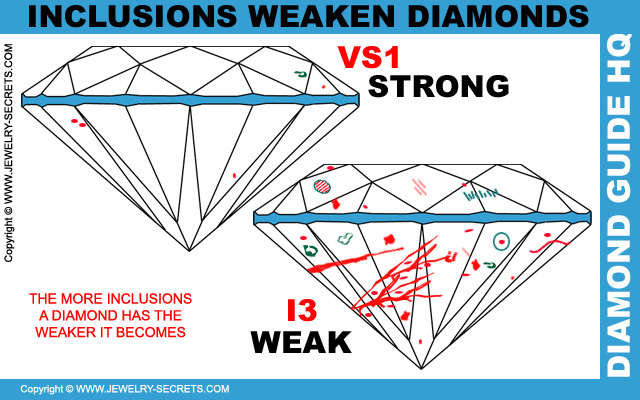
The more imperfections a stone has, the weaker the overall structure and integrity becomes… Which is a great reason why you should upgrade your stone!
I See Black Spots!
The good thing about Black Spots is the fact that they’re easy to spot, memorize and identify.
You can check them with the Diamond Plot on your Certificate and match up the flaws.
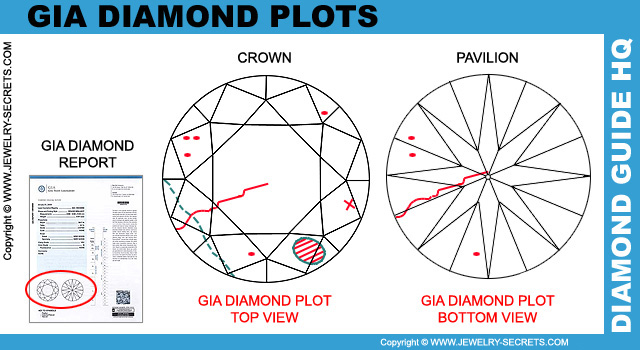
Knowing where your Inclusions are and what they look like will allow you to scope your Diamond anytime, anywhere and know that Diamond is yours.
You won’t have to worry about Diamond Switching!!!
PLUS, being an I Clarity Diamond, chances are good no Jeweler would want to swap it out anyway. What would they swap it with? Something better? I don’t think so.
SI Clarity can have Black Spots too
Now this may be surprising, but not all Black Carbon Spots show up in an I Clarity Diamond. Sometimes you’ll be able to see them in an SI Clarity (SI1 Clarity or SI2 Clarity) Diamond as well.
Granted, these Black Spots will be much smaller and microscopic, but they can indeed be black.
Usually if a Black Spot is in an SI Clarity Diamond, you will never see them with the naked eye… Except for one exception…
SI2 Clarity Diamonds
SI2 Clarity is the one Clarity that separates eye-visible Inclusions (I1, I2 and I3) from invisible Inclusions (SI1 and higher).
This one Category (SI2) splits the two and sometimes you can still see small Black Spots from the side view (looking at the stone from the side, not the top). See image below…
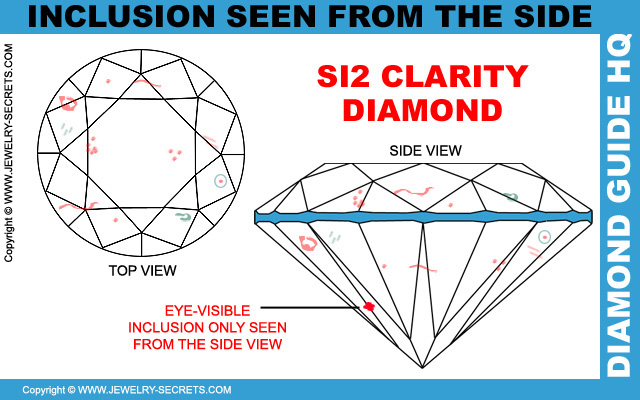
So the rule of thumb is, if you can see Flaws by looking straight down into your Diamond, it’s safe to say it’s an I Clarity Diamond (unless you have bionic eyes and can see microscopic inclusions).
Can Black Spots Grow?
Flaws and Imperfections in a Diamond will never grow, shrink, appear of disappear. They are permanent and will never move.
Some people claim that Black Spots weren’t in their Diamond the day they bought it, but I beg to differ. They are seriously mistaken. Just because they didn’t see the flaws doesn’t mean they weren’t there.
If they had microscoped the Diamond at the time of purchase, they would have seen the Spots.
Another simple clue would have been the Clarity. If you buy an I Clarity Diamond… You’re buying eye-visible Inclusions!!!
Get out a Microscope or 10x Jewelers Loupe and check it out…
If you don’t see Black Spots, that’s good. It can still have other things that make it an I Clarity: Fractures, Clouds, Pinpoints, Lines, Cracks, Cavities, Nicks…
One reason why Black Spots show up where there weren’t none before is this:
The Diamond is Dirty!
When your Diamond gets dirty, dust and debris on the outside of the Diamond block light from entering or exiting the stone. No Light = No Sparkle!
When your Diamond doesn’t sparkle, you’ll see more Flaws. Those beautiful flashes of white light and colored light do a great job at masking flaws and hiding spots.
So keep your Diamond clean and your flaws may stay unseen. ;)
Can you Remove Black Spots?
There is a technique in the Jewelry Industry that removes Carbon Spots. It’s called Laser Drilling and Fracture Filling.
Laser Drilling
Laser Drilling is where they literally drill a hole into the Diamond (usually through the Pavilion) all the way into the Black Spot where they will burn out or dissolve the Inclusion out leaving nothing but a Cavity (and tube) in its place. See image below…
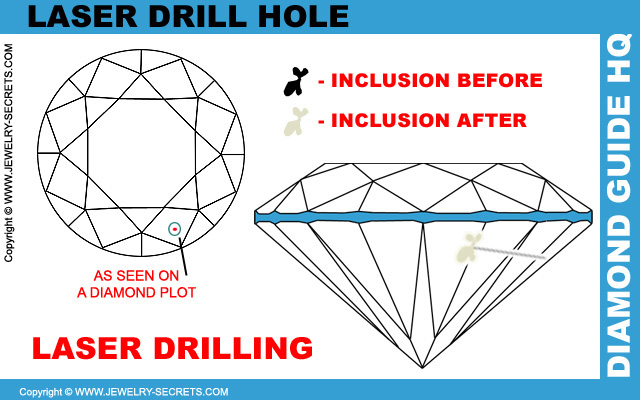
Fracture Filling
Sometimes they’ll then fill this Cavity with a clear substance that makes the hole blend in with the rest of the Diamond. That’s called Fracture Filling.
These procedures can raise the Clarity level of a Diamond. It can take an I Clarity Diamond all the way up to SI Clarity. The problem is, this tube and cavity can also weaken the Diamond’s structure and make it vulnerable to chipping or breaking.
What’s worse is this: If this process isn’t disclosed at the time of purchase, then it’s actually called FRAUD!
Fracture Filling MUST be stated upon purchase. That way you’ll know you’re buying a Diamond that’s been Clarity Enhanced (which should make the Diamond cheaper). The Jewelry Industry frowns upon this process because some people are purchasing altered stones and don’t know it. If you know it’s been enhanced and have no problems with it, all is good.
Hide Black Spots
Yes there are ways to hide a Black Spot… Well, almost.
If the spot falls on the outside edge of your Diamond, you can easily cover it with a Prong or part of the Mounting (like a Bezel Mounting). See image below…
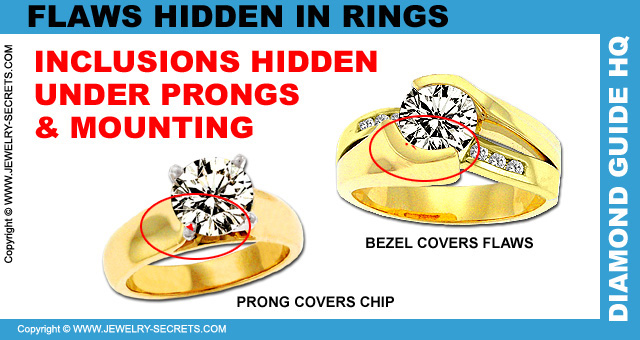
This is a great way to remove sightly Inclusions and no one will even know they existed.
If the Dark Inclusion falls towards the center of the stone, it gets pretty impossible to divert attention away from it. The simplest way is to just keep your Diamond clean so the sparkles block as many flaws as possible.
Some Inclusions are just too big and too obvious to hide. Some Inclusions in the wrong spot can actually replicate and look like 8 Inclusions instead. The Pavilion can act like a fun house full of mirrors and turn one Inclusion into many!
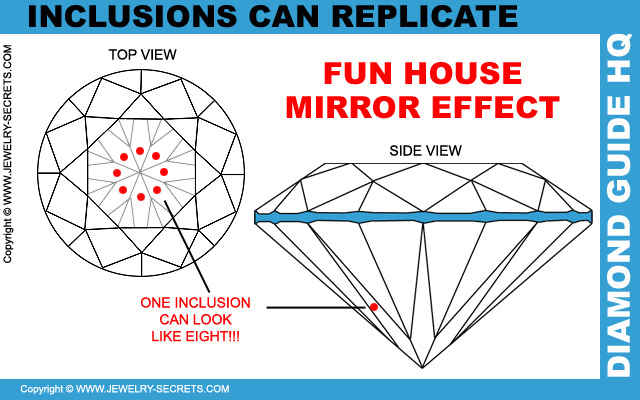
You’ll either have to accept these flaws (live with them), or upgrade.
Upgrade your Diamond
I’d suggest getting into an SI1 Clarity Diamond (or higher) if you want to get rid of all visible Flaws and Inclusions.
Or, if you haven’t had your Diamond long, maybe the Jeweler that you bought it from will allow you to exchange it for a better quality one?
Because, let’s face it, most people don’t realize what they’ve bought until it’s too late.
Only when they notice the Black Spots do they suddenly have an interest in Clarity. That’s why I always stress “Microscope every Diamond BEFORE you buy it!“
Make sure you understand what an I Clarity Diamond is. Make sure you learn about Inclusions and Flaws and reading Diamond Plots.
Above all else… Make sure you buy a Certified Diamond!
Certified Diamonds
Certified Diamonds pretty much guarantee that the quality listed on the report is the quality of Diamond you’re buying.
Certification is a MUST!
And here’s one more good point: Most Diamonds that you find on the market that are GIA Certified (the best in my opinion) are going to be SI1 Clarity or higher anyways. Why? Because Certification costs money and it’s not really worth it to Certify low grade stones… Unless it’s got a really good Cut or Color or Carat Weight – Something to offset it with.
When you buy higher quality, you want to be assured it’s high quality. But if you buy low quality, well, you already know it’s low. Why spend more money finding that out?
My Advice
The best Spot remover is preventive medicine.
Buy SI1 Clarity or higher and always buy Certified!
That way your fiancee won’t be trying to rub those ugly Black Spots away.
You want a Diamond she’ll be proud of. So don’t buy a stone riddled with Spots.
Because Diamonds are FOREVER…
And so are the FLAWS! :)














Dear sir/madam,
I have a ring left to me by my mother, it is set with five stones that I assume are diamonds. I have looked at them through a loupe and noticed some small black spots, the stones do not fog up when breathed upon, but the ring itself is silver. Is it possible for real diamonds to be set in silver, and can fake diamonds have black spots? My mother wore silver as opposed to gold because she preferred it. I look forward to your reply
Regards
Edward snelgrove
Hi Edward. Diamonds can absolutely be set in silver (or any type of metal). Chances are they are real diamonds, because fake diamonds fog up (for a short period of time) when you breath on then, but real diamonds do not because they retain heat. But then again, the stones could be any other type of transparent stone too (Sapphire, Topaz… CZ), which all could have black spots or flaws. Take the ring into a jewelry store and have them test the stones to be sure, but I would guess they were real. -Richard